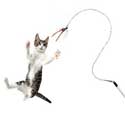Young active kittens and cats confined to a house with older cats are inevitably going to want to roughhouse and playchase those older cats. And the older cats, politely, are unlikely to respond aversively. Besides, fighting back might be fun for the kitten; keeping a low profile is probably a safer strategy.
It's my feeling that this sometimes troubles owners more than it troubles the cats themselves. However: you can help the cats out a little. Each cat should have its own hideyhole or home cage, a carrying case or small crate with solid (i.e. not wire) walls, preferably in an elevated and warm spot, where it can retreat and be left alone. Additional litter boxes are also a good idea.
And the kitten needs more to do. Target train the kitten with the clicker and then use the target to lead the kitten across obstacles and up or under the furniture, for clicks and treats, a few minutes morning and evening. This will give the kitten some exercise and something to think about, so it won't harass the older cats out of pure boredom nearly as much. You can also use a chase toy such as feathers on a spring, or the Cat Dancer, as a reward after the click for doing something strenuous such as a big jump from one chair to another. That way you wear the kitten out twice.
This does involve some effort on the owner's part: getting and reading the Clicker Training Kit for Cats, and learning to communicate with your cat through the clicker. But target training, the first exercise, is easy to do and takes about five minutes or less with most cats, after you find a preferred food. And the restless young cat will love you for it and find you more interesting than those old fogy cats, once it catches on. It's well worth the time to develop a little clicker skill, since you might after all have this kitten for 16 years as well, and come to love it greatly too.
Happy clicking,
Karen Pryor








Post new comment